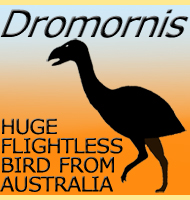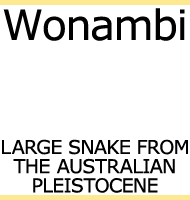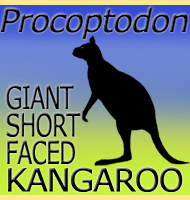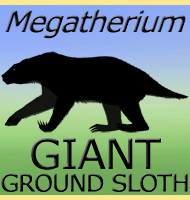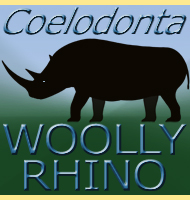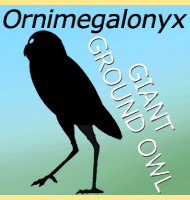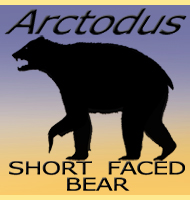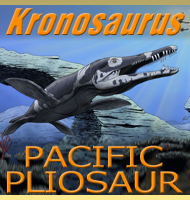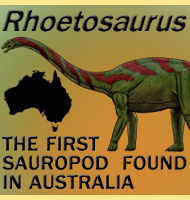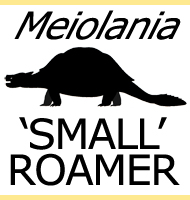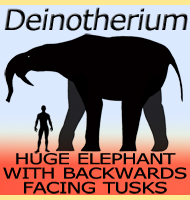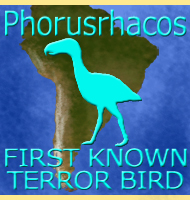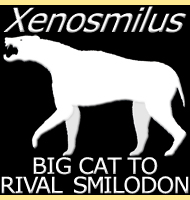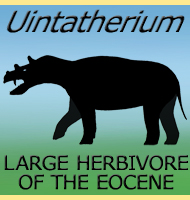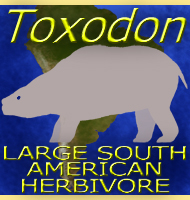


Diprotodon
a.k.a. 'Giant Wombat' and 'Rhinoceros Wombat'
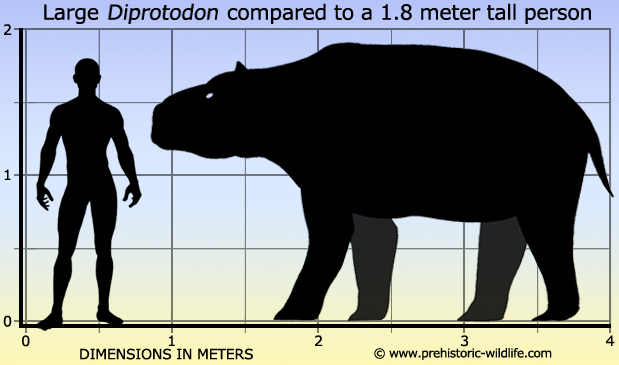
Name:
Diprotodon
(Two forward teeth).
Phonetic: Di-proe-toe-don.
Named By: Richard Owen - 1838.
Synonyms: See main text for explanation.
Classification: Chordata, Mammalia,
Marsupialia, Diprotodontia, Vombatiformes, Diprotodontidae.
Species: D. optatum (type).
Diet: Herbivore.
Size: Up to 3 meters long, 1.8 meters tall at
the shoulder. Possibly slightly bigger.
Known locations: Australia.
Time period: Calabrian to mid/late Tarantian of the
Pleistocene.
Fossil representation: Remains of hundreds of
individuals making this one of the best known megafauna animals from
Australia. Footprints and hair impressions are also known.
Diprotodon the
Giant Wombat
So
far not only is Diprotodon the largest of the
Australian megafauna,
but it is also the largest known marsupial mammal to ever exist.
Often loosely dubbed as rhinoceros-sized, there is some variation
between specimens which was once taken to indicate various species.
More modern analysis of the differences in these specimens has now
concluded however that these differences are between males and
females, something that has resulted in many previous species being
re-established as synonyms of the type species. The larger specimens
of Diprotodon have a greater incidence of injuries
to the bones which
has been interpreted that the larger specimens are of males that
regularly fought amongst themselves, possibly for access to females.
The
feet of Diprotodon were not found until later
discoveries were made,
but when found they revealed that they were plantigrade. This means
that Diprotodon walked with all of the bones
horizontally flat towards
the ground, an arrangement that would have offered the most support
for its large weight. These discoveries also revealed the toes
pointed inwards like in other wombats. Also like in other wombats we
see today, the pouch that young are kept in faces backwards. This
is an adaptation to prevent dirt collecting and building up in the
pouch as the wombat digs burrows, although given its large size,
Diprotodon almost certainly didn’t dig out
burrows, the adaptation
remaining more as a family trait inherited from smaller burrowing
ancestors.
Diprotodon
remains have been found in numerous locations and habitats that would
in the past have ranged from forest to grassland, suggesting that it
was a herbivore that could adapt to any ecosystem that supported the
growth of plants that it could browse from. Although usually
envisioned as browsing upon softer foliage, Diprotodon
may have used
its teeth to slice apart tougher plant parts.
Although
there were no predators like sabre toothed cats in Australia during the
Pleistocene, it was still a dangerous place to live. Smaller and
weaker Diprotodon would have been possible prey to
the marsupial lion
Thylacoleo.
Larger adults would have been harder to attack, but
they may have been at risk from the giant monitor lizard Varanus
priscus (previously called Megalania)
and
possibly even larger
species of the terrestrial crocodile Quinkana.
The Lake Callabonna fossils
Perhaps
the best known fossil site for Diprotodon is Lake
Callabonna, a dry
salt lake that is in the region of South Australia. Diprotodon
fossils of at least several hundred individuals have been found in this
location, mainly because during the Pleistocene, Lake Callabonna
was effectively a massive animal trap. As an inland lake,
Callabonna had a very high level of dissolved salts and other minerals
that would have leached in from the surrounding rocks as well as from
water courses and seasonal flood water. However with nowhere else to
go the mineral levels would steadily increase to well beyond the
amounts normally found in other bodies of water. In addition to this
the climate of Australia was steadily becoming drier during the
Pleistocene which means that the waters of Lake Callabonna would
periodically recede in times of low rainfall which resulted in the
dried out salts and minerals forming a crust across the ground.
However in the short term this crust would lay on top of the mud of
the lake bottom preventing further evaporation so that the mud stayed
soft and moist. This is where the danger was, as even though the
hard crust appeared to be a stable and safe surface, it was actually
very thin with the soft mud underneath providing no support.
Unaware
of the danger below them, Diprotodon would walk
across these flats
until they reached a location where the salt crust was at its weakest.
Because of their massive size, Diprotodon
carried a lot of weight
and their feet and legs would break through the crust and get stuck in
the mud below. As Diprotodon struggled to pull a
leg free it would
have to push down on the other three, possibly resulting in these
legs becoming stuck as well. Unable to free itself the individual
would be stuck there until it starved or possibly became prey to a
roaming predator. Diprotodon however was not the
only animal
recovered from Lake Callabonna, with the related Phascolonus,
the
kangaroos Protemnodon
and Sthenurus
and even the dromornithid bird
Genyornis
amongst others also being found there.
Diprotodon
specimens from Lake Callabonna have yielded some answers, but also
raised some questions as well. Because the legs would get stuck in
the mud these parts were the most protected from the environment and
scavengers, and gave the first indication of what the feet looked
like (up until this point other specimens had been lacking preserved
feet). However because the upper bodies were largely unprotected
they have suffered a lot of damage. Some of this would be caused from
scavenging animals, to damage from the elements such as erosion from
salt particles blown about by the wind. However many of these upper
skeletal bones have been interpreted as being trampled, possibly by
other Diprotodon, one of the few known animals
large and heavy enough
to do this kind of damage. This and the high number of remains
suggest that the Lake Callabonna region experienced a lot of animal
traffic, although possibly not as a watering hole as the high salt
content would have made the water undrinkable. It could be that as
dry and wet seasons progressed, much of the megafauna including
Diprotodon migrated to different areas for food,
trampling over the
scattered remains of the fallen individuals that died in years before
them.
Extinction
The
exact time and reason behind the extinction of Diprotodon
are both
subjects of strong opinion with many theories and ideas. When
considering the extinction of Diprotodon its best
to look at things
within the context of the bigger picture. When you drop one stone
into bucket of water waves ripple out to the sides and back for a short
amount of time before the water surface becomes smooth again. But
when you drop lots of stones in all at once the water surface becomes
far more turbulent and takes longer to settle. Dry periods were of
course nothing new to Diprotodon, but less water
and an increase in
arid habitats would have still have had the effect of placing
existing populations under stress. Here the weaker individuals such
as the very young, old and injured would have suffered the worst
resulting in lower total populations.
On
top of this came the first human settlers that in a new land would have
placed in a survival situation of finding enough food to live.
Easiest would have been hunting the local animals that were large
enough to feed several period while being easy enough to track down and
kill. Diprotodon ticks both of these boxes, and
with numbers
reduced even further by hunting the Diprotodon
would have had further
to go to recover to their original population level.
Another
effect of early humans would have been fire stick farming, a process
where areas of an ecosystem are deliberately set ablaze. One reason
for this is to encourage new plants to rise up out of the ash which
have lush growths that are easier to collect and eat than established
tougher plants. However the new plants that grow immediately in place
are not suited for all herbivores and the plants like some that
Diprotodon fed upon would need longer to grow back,
assuming of
course they could get re-established in the ecosystem. The result of
this is that Diprotodon would have begun to find
itself restricted to
unburned areas which were becoming smaller and smaller in area.
Any
one of these factors on their own may have been tolerable enough for
the species to survive, albeit in reduced numbers. All of these
things combined however would have exposed the populations of
Diprotodon, as well as other megafauna, to a
level of attrition
that proved too great a strain upon the species. Like with other
megafauna, not just in Australia but other parts of the world too,
the appearance of humans on the landscape may not have been the sole
cause of the extinction, but was a trigger event and contributing
factor that signals the demise.
The
very first people to settle in Australia are considered to have
appeared a little under fifty thousand years ago, and this is around
the time that much of the megafauna including Diprotodon
started to
disappear from the landscape. While most palaeontologists believe
this to have been the time of the extinction of Diprotodon,
older
studies suggested that Diprotodon may have lived to
as recently as
around thirty thousand years ago. Many have now pointed out though
that many of the early specimens were not found in their original level
of strata and had in fact become dislodged and redeposited into a
different area that is from a more recent age. This process could be
as simple as a fossil bone protruding out from a weathered rock to be
dislodged and washed away by wet season flood water.
Carbon-14
dating is an often mentioned process that was the mainstay for dating
geologic and fossil samples during the latter half of the twentieth
century, but was limited to no more than forty-five thousand years
ago at best. Newer and more sensitive techniques developed since the
early twenty-first century however have now pushed this boundary
further back, with early indications suggesting that Diprotodon
really did disappear around fifty thousand years ago. This confirms
the results of more detailed study of the strata that Diprotodon
remains have come from, and unless new discoveries in the future
prove otherwise, just under fifty thousand years ago is the date that
most modern palaeontologists hold to.
Further reading
- Taxonomy and palaeobiology of the largest-ever marsupial, Diprotodon
Owen, 1838 (Diprotodontidae, Marsupialia) - Zoological Journal of the
Linnean Society 153 (2): 369–397 - G. J. Price - 2006.
- Late-surviving megafauna in Tasmania, Australia, implicate human
involvement in their extinction - Proceedings of the National Academy
of Sciences of the United States of America - Chris S. M. Turney,
Timothy F. Flannery, Richard G. Robertsa, Craig Reide, L. Keith
Fifieldf, Tom F. G. Higham, Zenobia Jacobs, Noel Kemp, Eric A.
Colhouni, Robert M. Kalinj & Neil Ogle - 2008.
- Taxonomy and palaeobiology of the largest-ever marsupial, Diprotodon
Owen, 1838 (Diprotodontidae, Marsupialia). - Zoological Journal of the
Linnean Society. 153 (2): 369–397. - G. J. Price - 2008.
- Gigantism of the Australian Diprotodon Owen 1838
(Marsupialia,
Diprotodontoidea) through the Pleistocene. - Journal of Quaternary
Science. 24 (8): 1029–1038. - G. J. Price & K. J. Piper - 2009.
- Climate change frames debate over the extinction of megafauna in
Sahul (Pleistocene Australia-New Guinea). - Proceedings of the National
Academy of Sciences. 110 (22): 8777–8781. - Stephen Wroe, Judith H.
Field, Michael Archer, Donald K. Grayson, Gilbert J. Price, Julien
Louys, J. Tyler Faith, Gregory E. Webb, Iain Davidson & Scott
D. Mooneya - 2013.
- Cranial biomechanics, bite force and function of the endocranial
sinuses in Diprotodon optatum, the largest known
marsupial. - Journal
of Anatomy. 228 (6): 984–995. - Alana C. Sharp & Thomas H. Rich
- 2016.
- Seasonal migration of marsupial megafauna in Pleistocene Sahul
(Australia–New Guinea). - Proceedings of the Royal Society B:
Biological Sciences. 284 (1863): 20170785. - Gilbert J. Price, Kyle J.
Ferguson, Gregory E. Webb, Yue-xing Feng, Pennilyn Higgins, Ai Duc
Nguyen, Jian-xin Zhao, Renaud Joannes-Boyau & Julien Louys -
2017.
----------------------------------------------------------------------------
Random favourites
 |
 |
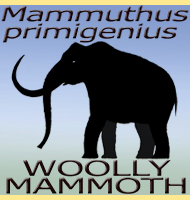 |
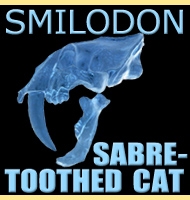 |
